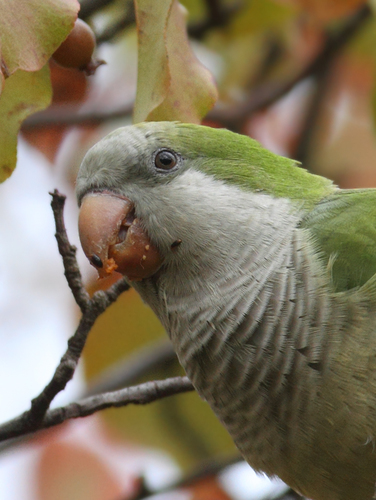
Monk Parakeet
The Monk Parakeet (Myiopsitta monachus), also known as the Quaker Parrot, is a vibrant and intelligent species native to South America. Uniquely among parrots, it builds large, communal stick nests, often in urban environments. This adaptability has allowed it to establish feral populations worldwide, making it both a beloved pet and, in some areas, an agricultural pest. Its social behavior and vocalizations are complex, and its presence in non-native regions raises interesting ecological questions about competition and adaptation.
28-30 cm
Length
48-53 cm
Wingspan
Least Concern
Conservation Status
Distribution
Native to South America, specifically Argentina, Brazil, Uruguay, Paraguay, and Bolivia. Feral populations have established in North America (especially the United States), Europe, Africa, and Asia. They often thrive in urban and suburban areas.
Lifespan
20-30 years in captivity; lifespan in the wild is less well-documented but likely shorter.
Monk Parakeet's Habitat
Habitat Types
Savannas, Open woodlands, Agricultural areas, Urban parks and gardens
Climate Zones
Subtropical, Temperate
Adaptations
Highly adaptable to various food sources and nesting sites. Their ability to build their own nests, rather than relying on tree cavities, allows them to thrive in diverse environments, including those with limited natural nesting opportunities.
Variations
Several subspecies are recognized, differing slightly in size and coloration. These include *M. m. monachus*, *M. m. calita*, *M. m. cotorra*, and *M. m. luchsi*.
Appearance
Breeding Plumage
No significant difference between breeding and non-breeding plumage.
Seasonal Feather Changes
No significant seasonal variations.
Sex Based Plumage Differences
Minimal; males and females have similar plumage.
Notable Features
Bright green upperparts, Pale grey face, throat, and breast, Yellowish-green abdomen, Blue flight feathers, Long, pointed tail
Diet and Feeding
Primary Foods
Seeds, Fruits, Nuts, Berries, Flowers, Leaf buds, Insects (occasionally)
Foraging Behavior
Forages in flocks, often on the ground or in trees. They are known to be adaptable and opportunistic feeders, taking advantage of available food sources.
Specializations
Strong beak adapted for cracking seeds and nuts. They use their feet to hold and manipulate food items.
Seasonal Diet Variations
Diet varies depending on seasonal availability of food. For example, they may consume more fruits during fruiting seasons and more seeds during other times.
Behavior
Social Structure
Highly social; lives in colonies that can range from a few pairs to hundreds of birds. These colonies build and maintain large, complex nests.
Communication
Loud, raucous calls, Variety of squawks and chatters, Contact calls to maintain flock cohesion
Migration
Generally non-migratory, although some populations may make local movements in response to food availability. Feral populations are typically resident year-round.
Territorial or Group Behaviors
Defends the nest and immediate surrounding area. Within the colony, there is a social hierarchy, but cooperation in nest building and defense is common.
Conservation
Threats
Habitat loss (in some parts of their native range), Persecution as agricultural pests (in some regions), Trapping for the pet trade (historically, but now less common due to established feral populations)
Protection Programs
CITES Appendix II (regulates international trade), Some local regulations in areas where they are considered pests
Local National Laws
Varies widely. In some areas, they are protected, while in others, they are considered invasive and may be subject to control measures.
Population Trend
Stable
Population Estimates
Global population is difficult to estimate due to widespread distribution and feral populations, but considered to be large and not currently threatened.
Interesting Facts
They are the only parrot species that builds a stick nest.
This unique behavior sets them apart from other parrots, which typically nest in tree cavities.
Their communal nests can weigh hundreds of kilograms.
These massive structures are built and maintained by the entire colony.
Feral populations have adapted to survive cold winters in North America and Europe.
This demonstrates their remarkable adaptability to different climates.
Monk Parakeets are known for their playful nature.
They often engage in social play, such as chasing and tugging on objects.
Faqs about Monk Parakeet
Are Monk Parakeets good pets?
They can be good pets for experienced bird owners, as they are intelligent and social but require significant attention and mental stimulation. They can also be very loud.
Are Monk Parakeets invasive?
They are considered invasive in some areas where feral populations have become established, as they can compete with native birds for resources and sometimes damage crops.
How can I tell the difference between a male and a female Monk Parakeet?
It is difficult to visually distinguish between male and female Monk Parakeets. DNA testing or surgical sexing are the most reliable methods.
What do I do if I find a Monk Parakeet nest?
It's best to observe the nest from a distance and avoid disturbing the birds. If the nest is causing problems, contact your local wildlife authority for advice.
Copyright @ Nature Style Limited. All Rights Reserved.
 English
English